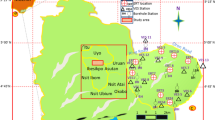Abstract
The paper shows that isoresistivity contours for different depths, drawn from interpreted resistivity values, can indicate the location of underground lineaments. A comparison of the surface lineament map with the maps of isoresistivity contours for different depths shows that many of the underground lineaments recognised through the resistivity studies have surface expressions as lineaments. The underground lineaments allow large-scale migration of groundwater and can be used as sites for the artificial recharging of aquifers. It is concluded that the maps prepared from interpreted resistivity values derived by curve matching can give a better picture of the underground structures than the conventional maps prepared from apparent resistivity values.
Résumé
L’article montre que des courbes d’isorésistivité établies pour différentes profondeurs à partir de l’analyse de données de résistivité, peuvent indiquer la localisation de linéaments profonds. Une comparaison d’une carte de linéaments de surface avec une carte d’isorésistivité pour différentes profondeurs montre que beaucoup des linéaments profonds reconnus par les études de résistivité correspondent à des linéaments identifiés en surface. Les linéaments profonds sont à l’origine d’écoulements souterrains à grande échelle et peuvent être utilisés comme sites de recharge artificielle des aquifères. On peut conclure que les cartes obtenues après analyse de valeurs de résistivité peuvent donner une meilleure image des structures profondes que les cartes conventionnelles obtenues à partir de valeurs de résistivité apparentes.





Similar content being viewed by others
References
Anbazhagan S (1993) Fracture pattern study for groundwater exploration in part of Dharmapuri district. Bhu-Jal News, Tamilnadu, pp 8–12
Anbazhagan S, Ramasamy SM (1997) Geophysical resistivity survey and potential site selection for artificial recharge in central Tamil Nadu. In: Marinis PG, Koukis GC Tsiambaos GC, Stournaras GC (eds) Engineering geology and the environment. Brookfield 2:1169–1173
Aswathanarayana LG and Srinivas G (1991) Resistivity survey of Ghataprabha river basin in parts of Karnataka and Maharashtra, South India. In: Proceedings of the First International Seminar and Exhibition on Exploration Geophysics in Nineteen Nineties. Association of Exploration Geophysicists, Hyderabad, 1:262–269
Balasubrahmanyan MN (1978) Geochronology and geochemistry of archaean tonalitic gneisses and granites of South Kanara district, Karnataka state India. In: Windley BN and Naqvi SM (eds) Archaean Geochemistry. Elsevier, Amsterdam, pp 59–78
Chandrasekharappa KN (1989) Morphometric analysis of Nethravathi river basin, Karnataka, India. Unpublished Thesis Ph.D. Mangalore University, India
Ganesh Raj K (1994) Major lineaments of Karnataka and their significance. In: Ravindra M and Ranganathan N (eds) Geo Karnataka. KAGA, Bangalore, pp 303–313
Jaganathan V (1994) Groundwater exploration. In: Ravindra M, Ranganathan N (eds) Geo Karnataka. KAGA, Bangalore, pp 372–380
Kaila KL, Roy Chowdary K, Reddy PR, Keishnan VG, Hari Narain, Subbotin, SE, Sollogub VB, Chekunov AV, Kharetchko TV (1979) Crustal structure along Kavali– Udupi profile in the Indian peninsular shield from deep seismic sounding. J Geol Soc India 20:307–333
Kunze AWG (1998) Implications of electrical resistivity data regarding ground-water lenses on San Salvador island. Bahamas Environ Enginner Geosci IV:55–76
Muralidharan D (1996) A semi-quantitative approach to detect aquifers in hard rocks from apparent resistivity data. J Geol Soc India 47:237–242
Osella A, Favetto A, Martinelli, P, Cernadas D (1999) Electrical imaging of an alluvial aquifer at Antinaco-Los Colorados tectonic valley in the Sierras Pampeanas. Argentina Appl Geophys 4:359–368
Rajesh Reghunath (1999) Hydrogeological studies of Nethravathi river basin, Karnataka state, India. Unpublished Ph.D Thesis, Mangalore University, India
Rajesh Reghunath, Sreedhara Murthy TR, Udaya shankar HN (2002) Electrical resistivity survey to demarcate potential sites for groundwater and artificial recharging in a part of PreCambrian crystalline province of peninsular India. J Appl Hydrology XV:39–48
Raju NJ, Reddy TVK, Nayudu PT (1996) Electrical resistivity surveys for groundwater in the upper Gunjanaeru catchment. Cuddapah district Andhra Pradesh 47:705–716
Ramanujachary KR, Balakrishna S (1985) Resistivity investigations in different geological terrains. Groundwater News pp 1–14
Ravi Prakash S, Krishna Rao G (1991) Geo-electrical resistivity studies of Paravada area, Visakhapatnam District, Andhra Pradesh. Hydrology J IAH XIV:1–15
Singhal DC, Sri Niwas, Shakeel M, Adam EM (1998) Estimation of hydraulic characteristics of alluvial aquifers from electrical resistivity data. J Geol Soc India 51:461–470
Subrahmanya KR, Gangadhara Bhat H (1995) Revised geological map of Dakshina Kannada—utilising IRS data and aerial photographs. In : Muralikrishna IV (ed) Remote sensing and GIS for environmental planning. Tata Mc Graw–Hill Publishing Company Ltd, New Delhi, pp 160–165
Subrahmanya KR, Gangadhara Bhat H (1997) Faults and mass movements in the Western Ghats scarp of the Nethravathi river basin. In : Muralikrishna IV (ed) Geographical information systems and remote sensing applications. Allied Publishers Ltd, Bangalore, pp 236–240
Subrahmanya KR, Rao BRJ (1991) Marine geological aspects of Dakshina Kannada coast. In: Ramachandra (ed) Perspectives on Dakshina Kannada and Kodagu, Mangalore University Decennial Volume, pp 201–220
Suresh TS, Naganna C, Srinivas G (1992) Exploration for groundwater in Hemavathy river basin, Karnataka: Using resistivity techniques. J Indian Acad Geosci 35:25–30
Vander Velpan BPAL (1988) Forward resistivity model, M.Sc. Research Project, I.T.C. Kannel Weg, 32628. Delft, The Netherlands
Verma RK, Rao MK, Rao CV (1980) Resistivity investigations for groundwater in metamorphic areas near Dhanbad, India. Ground Water 18:46–55
Acknowledgements
The author is grateful to Mangalore University for awarding the university doctoral research fellowship.
Author information
Authors and Affiliations
Corresponding author
Rights and permissions
About this article
Cite this article
Reghunath, R., Murthy, T.R.S. & Shankar, H.N.U. Delineation of concealed lineaments using interpreted resistivity values. Bull Eng Geol Environ 64, 209–215 (2005). https://doi.org/10.1007/s10064-005-0274-9
Received:
Accepted:
Published:
Issue Date:
DOI: https://doi.org/10.1007/s10064-005-0274-9




